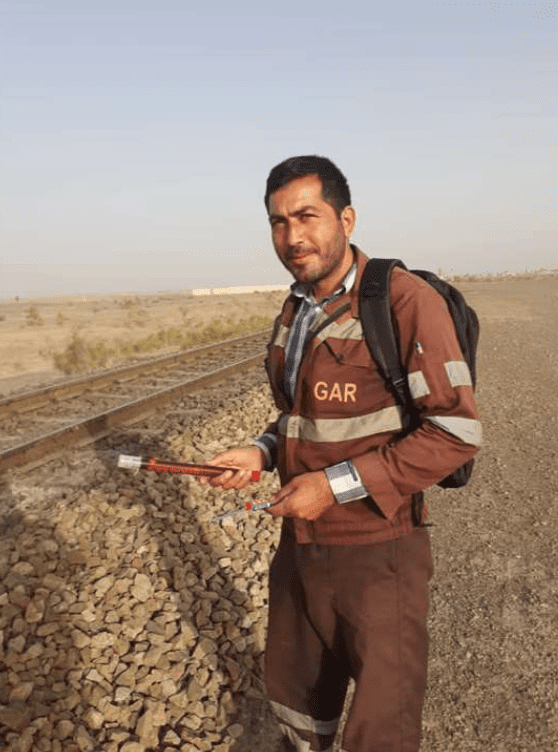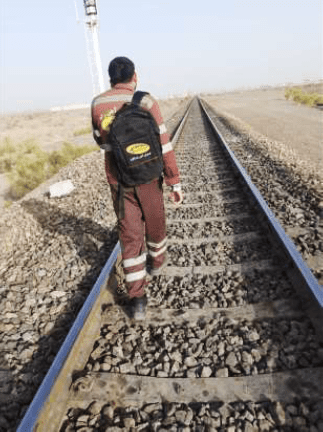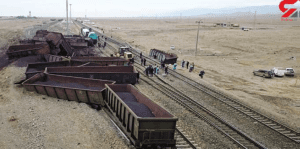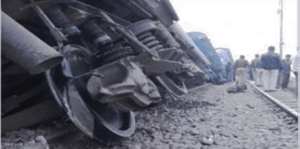Appreciation and thanks to lengthsmen of Nain

Lengthsmen As one of the arms of the organized cycle of monitoring the tracks and railroad technical buildings, the lengthsman monitors and removes possible faults in tracks and the technical buildings by walking on the ballast (the rocks inside the railroad tracks) from the beginning of the building of the tracks in the best and worst weather, climate and environmental conditions and if he can’t operate individually, he will inform the first repairs group.
A complete description of duties and how the lengthsmen operate is discussed in article 21 of the General Regulations of Railway.
Now, based on the aforementioned, we should consider that if a lengthsman walks 20 kilometers (back and forth) monitoring the tracks and technical buildings, having 6 work days during a week and 30 years of service; by the time he is retired, he will have walked approximately 187700 kilometers on ballasted tracks carrying equipment and having 8-hour walks to carefully monitor railway tracks and technical buildings.
In other words, it is equal to 4.7 times walking on the equator around the earth.
A lengthsman walks more than 4.5 times around the earth on the equator (biggest earth orbit) during his 30 years of service.
B. Lengthsman duties
In tracks which the presence of a lengthsman is determined, he must walk the lengths of the track to monitor the tracks in the area that were dedicated to him carrying green and red flags, six firecrackers, two fused candles, special tools proper for the connections of tracks and sleepers of the area, lamp, and matches.
The lengthsman must know all the track and train signs and be familiar with how to block the track.
While monitoring, the lengthsman must inspect all the tracks, connections, bolt and nut connections, sleepers, trenches, and gutters and must put a sign at the moment of finding faults he cannot fix, then he will report to the supervisor of the first repairs group to fix the problem and when returning, he will check to make sure that the fault is fixed.


While inspecting the tracks, if the lengthsman observes that due to any reason some parts of the tracks are impassable, he is obligated to block the side according to the signs regulations and then if he has access to any means of communication, he must notify the stations on the two sides. Otherwise, he starts moving toward the nearest station at once to announce the incident and if he sees any trains, he stops them until the officers notify the stations on the two sides to take necessary actions.
If he deems the fault passable, after stopping the train he will carefully and safely pass the train from that part using the cooperation of officers and sends a proper message by the officers to notify the station.
The lengthsman is obligated to stay near the tracks while the trains are passing and notify the officers of his presence by presenting an open flag or lamp.
Monitoring the railway zone that is outside the exit switches of stations is the responsibility of the lengthsmen and if they observe any trespassing they are obligated to stop it and report it to responsive authorities at once.
The lengthsmen are obligated to always walk on the right side of the tracks on the embankment shoulder.
On two-track railroads, if both of the tracks are blocked and impassable at the same time, the lengthsman is obligated to immediately block both tracks.
C. Description of the event
Commitment and conscientiousness are among the highest human qualities. Since honoring this commitment is a reminder of this excellence, it must be taken into consideration. This commitment will have its greatest manifestation and effect in the railway and if commitment and conscientiousness are mixed with workplace safety, they will prevent biter accidents without a doubt. One of the important jobs in the railway which serves as the position of tracks and technical buildings inspector is the lengthsman.
This job is considered to be the eyes of the system which is always able to report great volumes of faults in tracks and technical buildings. Since any carelessness in identifying and recording the faults in the railway industry could lead to dire accidents and events, properly performing the duties is a necessity. One of the faults happening in the railway industry that has caused much human life and financial losses in the past years is the inspection of axle journal bearing of the wagons.


Although according to the job description, inspecting the axle journal bearing of wagons is not among the duties of the lengthsman, reporting this type of fault from other units is considered a beyond-duty act and in terms of value, it will undoubtedly have a high position. Based on what is mentioned or recorded above, the aware lengthsman of Zavareh, “Mr. Mojtaba Zagholi Jan Abadi, born in 1988/06/26 in Isfahan who was employed by Gostaresh Ahan Rah Company in 2014/09/14 and has successfully passed the special lengthsmanship course in 2018”,while inspecting the Mahabad-Badrood block in that time, he witnessed the hotness and change of color in the pulley of axle journal bearing of a wagon of a passing train with his carefulness. Based on his experience and knowledge, he immediately called Mahabad station and notified the traffic of that station that the axle journal bearing is broken. The station traffic too, immediately communicated with the wagon master and locomotive driver through radio communication and ordered the train to stop, and emphasized the inspection of the reported wagon by the lengthsman. After the inspection of the mentioned wagon by the wagon master, the correctness of the report was confirmed. In coordination with the control and traffic of the area, the wagon master disconnected the faulty wagon from the train and the rest of the train continued its journey.
It is worth mentioning that the same type of fault had happened in the same block which in addition to damaging about 15 kilometers of track had resulted in 11 billion tomans (275,000$) of financial loss.


